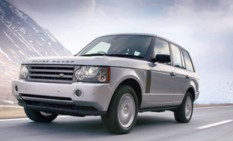Review
THERE are plenty of elements to the Range Rover that are wonderful: it oozes style, space, sophistication is spacious and comfortable, for instance.
However, the awful diesel engine has never been one of its strengths. Underpowered and unrefined, it has done an injustice to Land Rover’s luxury beast.
Time for a change: and the firm reckons a fresh benchmark will be set in sport utility refinement when its new diesel goes on sale this month.
Claimed to be one of the most advanced diesel units available, the new 3.6-litre twin-turbo V8 is apparently up to 75% quieter than the straight-six it replaces. But its combination of massive output and torque also make it quicker off the mark and faster all-out without any loss of economy.
‘This car is another great step in the evolution of our company and we are very excited about its prospects. We already fit diesel engines to 60% of the 5,000 Range Rovers we sell each year, but we think that proportion will rise to 85% because the TDV8 is spot on for the UK market. We are confident it will secure more business for us with user-choosers,’ said Land Rover UK managing director John Edwards.
So little noise comes from the new turbodiesel engine that a special device has been developed to prevent owners from filling the car with petrol.
Chief programme engineer Paul Walker said: ‘To say that we are proud of this engine is something of an understatement – we’re absolutely thrilled with it.
‘But as it spins so readily and is so quiet in operation, we think there is a real risk that owners can forget that they’re driving a diesel. We’ve had to come up with a system to make sure the car isn’t filled with petrol by mistake.’
Called Fuel Guard, the novel gadget seals the filler pipe if the driver selects the wrong fuel pump – an error the AA estimates results in garages having to drain more than half-a-million litres of fuel each year from contaminated systems.
The brainchild of one of the company’s engineers, the patented, plastic device promises to save a lot of embarrassment as well as repair bills that can reach £5,000 when a new engine is needed.
Land Rover engineer Grant Horne said: ‘The concept is remarkably simple and we’ll offer it on all our products in due course. Because petrol pump nozzles are smaller than those for diesel, they reach further down the neck of the car’s fuel filler pipe. When this happens, the nozzle comes into contact with sensors that activate a flap to prevent petrol entering the tank.’
Developed jointly by Ford and PSA Peugeot Citröen, the 3.6-litre twin-turbo TDV8 engine develops 272bhp and 472lb-ft of torque, improvements of 54% and 64% respectively over the outgoing engine.
Indeed, at little more than idle speed, the TDV8 delivers more torque than its predecessor’s maximum output.
With that level of power under its bonnet, the diesel Range Rover now has the on-road demeanour to match its higher-luxury guise. More significantly, it offers performance on a par with its 4.4-litre, V8 petrol counterpart, but with vastly superior operating economy – the petrol manages less than 19mpg.
For all 2001 models, an extended Terrain Response system now covers almost every driving condition with five engine and suspension settings. Along with a centre electronic differential, this brings greater off-road capability under fingertip control to make it even easier to enjoy progress over rough ground in armchair comfort.
A major rethink on air conditioning means the car is better cooled, with a higher capacity evaporator removing 15% more heat from the cabin even though ventilation fans make less noise.
Side airbags are now seat-mounted to give improved cushioning and an inflatable bolster is added to protect the driver’s knees.
Behind the wheel
PETROL? Just forget it.
With all this power, torque and engineering finesse on offer, the case for having diesel under the bonnet of a Range Rover has never been stronger.
Add economy of more than 25mpg into the equation and there’s simply no point in considering anything other than diesel for the ‘Best 4x4xFar.’
I wouldn’t question Land Rover’s prediction of a big swing to diesel with this model, which is as satisfying on the road as it is capable off it, because high-grade suspension and near 50-50 weight distribution promote impeccable composure for confident high-speed motoring.
As part of a full-scale interior makeover, the car has a neater centre console, an electronic parking brake, more wood trim and revised front seats with heating and active headrests.
And to make sure all sources of extraneous noise are kept from the cabin, the windscreen is made from acoustic laminated glass.
The result beefs up a supremely comfortable premium environment that feels ideally suited to long-haul travel in style, thanks to a commanding driving position that provides the best possible view of the road ahead – and a generous fuel tank capacity allowing a theoretical range in excess of 550 miles.
Fact file
Model: TDV8
Max power (bhp/rpm): 272/4,400
Max torque (lb-ft/rpm): 472/2,000
Max speed (mph): 124
0-62mph (secs): 9.2
Fuel consumption (mpg): 25.1
CO2 emissions (g/km): 299
On sale: October
Prices (OTR): £53,995- £68,825
| Image gallery | ||||||
 |
 |
 |
||||
















